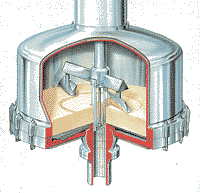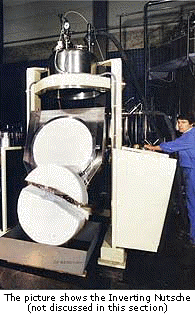
|
Click on the
thumbnail to maximize the image |
The Nutsche Filter is the industrial version of the well known laboratory scale Buchner Funnel except that it is designed to operate under either on vacuum or pressure. In their modern version they were developed in the early 80's and the majority operates, usually under pressure, in batch oriented industries such as fine chemicals, dyes, pharmaceutics and pesticides.
Present day Nutsche Filters are constructed to perform a multitude of tasks including reaction, filtration, cake washing and thermal drying on a single unit. As such these are very sophisticated machines with tight process control on parameters such as pressure, temperature and pH. Nutsche Filters are well suited for handling flammable, toxic, corrosive and odor-noxious materials since they are autoclaved and designed for use in hazardous and ex-proof environments when extremely safe operation is required.
Nutsche Filters are available in almost any size with the larger machines for a slurry filling batch of 25 m3 and a cake volume of 10 m3. Such filters have a filtration area of 15 m2 and are suitable for fast filtering slurries that produce readily 0.5 m thick cakes.
The Nutsche in its full configuration consists of four major components:

All these components may be constructed from exotic materials of construction and heated to meet the process requirements.
The Vessel
|
Nutsche Filters are operating as part of a batch system hence the vessel's volume is designed to accept an entire charge of slurry from the upstream equipment. Therefore, so that the idle time of the filter is kept to a minimum, sufficient holding volume is required for fast charging and emptying of the vessel. The vessels are generally designed for an operating pressure of 2-3 bars but higher pressures may be specified if required. The vessel's cover supports the hydraulic system that controls the independent raising and lowering of the rotating auger and reslurry paddle arms as well as the various flanged connections and maintenance manhole. There are two types of vessels:
For applications that require preservation of temperature the vessel may be double-walled or half-pipe jacketed to provide effective heat transfer to the product.
|
The Filter Floor and Filtering Medium
The filter floor consists of a densely perforated plate sufficiently strong to hold the cake weight and the pressure that is exerted on the cake's surface. On the larger filters additional support to the plate is given by ribs between the vessel's floor and the filter plate.
There are three types of filter medium that cover the filter plate:
The selection depends entirely on the characteristics of the solids, the liquid and the appropriate materials of construction. Medium selection cannot be determined on a bench scale leaf test and it is only pilot testing that can establish long term effects such as medium blinding and fluctuations in the feed properties.
The Arms for Reslurrying, Cake Smoothing and Discharge
The cake may be conveyed for discharge towards a piped chute that is
positioned in the center of the vessel or towards an outlet positioned on the
vessel's cylinder just above the filter plate.
The two options of cake discharge may be viewed on the image to the right and both discharge a delumped cake. The image below illustrates a cake that discharges in one piece from an Inverting Nutsche Filter that is not discussed in this section.
The Control System
The control system for modern Nutsche Filters is very sophisticated since it activates and deactivates many components as may be seen in the section Operational Sequence.

Advantages
Nutsche Filters are best selected in the following instances:
Disadvantages
They should be selected with care:
|
The operation of Nutsche Filters requires a complex manipulation of valves and hydraulics so present day installations are always semi or fully automated. Filtration The filter is charged with slurry and pressure is applied to displace the filtrate leaving the cake retained over the filter medium. For slurries with a wide distribution of coarse fast settling solids and slow settling fines there is a risk of segregation with the finer fraction settling over the coarse fraction. When this happens the fines seal the cake and slow down the cake formation so keeping the slurry in suspension with rotating arms during filtration assists in forming a homogeneous cake. Cake Washing In the washing stage a spray ring or connections on top of the cover introduce the wash liquid over the cake. This displaces the mother solution with the wash liquid but with such in-situ washing the efficiency may be quite low if the cake forms with an uneven thickness. One of the advantages of the Nutsche Filter is the ability to smoothen the cake's surface prior to applying spray wash so that the entire bed is washed evenly. Washing efficiency may be further improved if air or gas are not allowed to enter the cake in a multi-washing system so the wash liquids always displace the solutions in a "piston" like manner. This is achieved by a special detector that monitors the surface of the cake for moisture and once air or gas start entering the bed a signal is transmitted to close the filtrate valve and reopen it once next washing commences. Cake Repulping Many processes require high washing efficiency to remove the contaminating liquid from the product and washing the cake by repulping yields the most efficient product purity. This is done by resuspending the cake with the paddle arms for thorough mixing with the wash solution. During resuspension the rotating arms are moving slowly downwards and are "shaving" the bed gradually layer after layer until the entire cake enters the slurry. Pressure Drying In the drying stage air or gas purges the cake until the captive moisture is reduced to an asymptotic level and in practical terms the cake is considered to be as dry as possible. To obtain minimum moisture the cake is smoothened by reversing the rotation of the paddle or auger arms and exerting controlled pressure on its surface with the hydraulic system. This seals cracks in the cake so that air or gas will not bypass the bed. Vacuum Drying Further reduction in cake moisture may be obtained by slowly rotating and lowering the paddle arms to scrape and delump the cake. To take advantage of the drying ability of the Nutsche Filter it is worth considering the option of heating components such as the vessel, filter floor and paddles to enhance drying. Cake Discharge Once all the stages are completed the cake discharge valve opens and the paddle arms on the smaller machines or the auger arms on the larger ones are rotated and lowered to convey the dry cake towards the center. The same procedure also applies to side discharge machines however it should be noted that in this case the cake comes out intermittently and not continuously. This may have a layout impact on the downstream facility such as the conveyor that handles the product to storage. On some filters the cloth or woven mesh screen may be backwashed with water to dislodge and remove any cake residue that adhered to the medium after cake discharge.
MaintenanceThe Nutsche Filter requires attention on a regular basis to safety devices and automation features that accompany modern filters. The major components to take care of are:
|